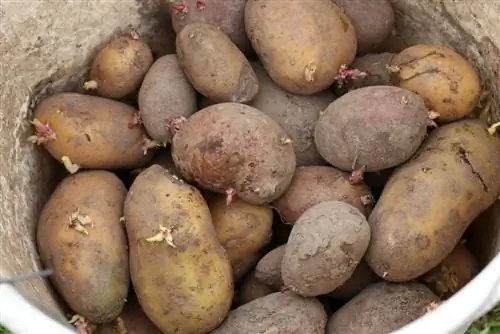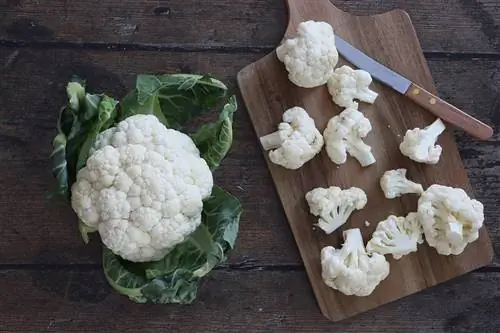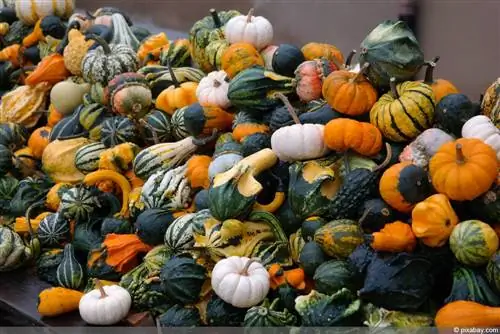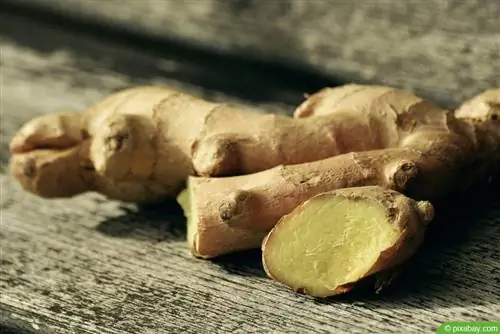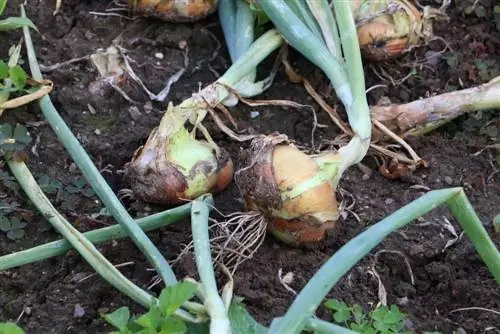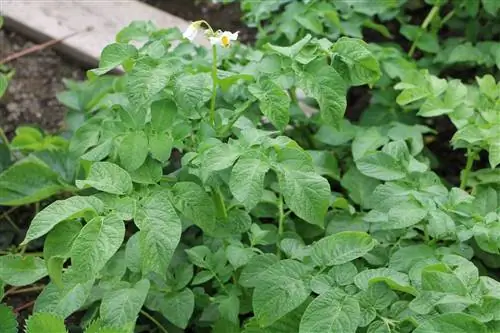- Author admin [email protected].
- Public 2023-12-17 03:39.
- Last modified 2025-01-24 12:45.
You can find more than a hundred types of potatoes across Germany. They differ primarily in the firmness of the tubers and according to ripening groups, starting from early to medium early to late varieties. The maturity group, along with a number of other factors, also plays an important role in storage life. Under optimal conditions, the potato, also known as the potato, can be stored for months.
Don’t harvest storage potatoes too early
The prerequisite for the longest possible storage life is the correct harvest time. In general, the potato can be harvested when the herb is completely dead. In contrast, with cellar potatoes you should wait two to three weeks after the above-ground parts of the plant have died before removing them from the ground.
During this time, the shell of the mature tubers becomes firmer and can therefore better protect them from rot pathogens. To harvest, choose a dry day and let the vegetables dry in an airy place protected from rain before storing them in the cellar. When storing, you should know that not every type of potato is suitable for longer storage.
Storage life depends on variety
As already mentioned, the storage life of potatoes depends on the respective variety and the associated ripening times. Accordingly, there are early, mid-early and late varieties. Early varieties are harvested from June. They are generally not storage potatoes and can be harvested when the leaves are still green. They are best enjoyed fresh.
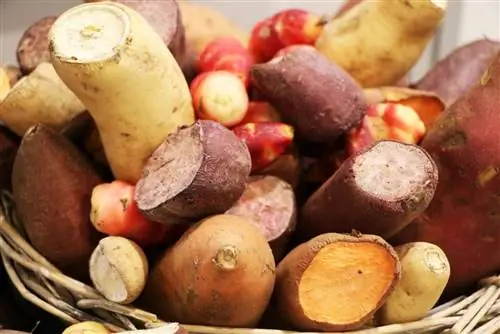
Mid-early ones, which can be harvested from around the beginning of August, already have a thicker shell and can be stored for up to three months. Late varieties are ready to harvest from September to the end of November and should remain in the ground as long as possible. Thanks to their thick skin and high starch content, varieties harvested in autumn make the perfect storage potatoes. High-quality potato varieties that store very well include: 'Linda' and 'Algria'. In order to be able to use the cellar potatoes for as long as possible, there are a few basic things to consider when storing them.
Tip:
Only specimens with an undamaged shell, no rot or germs may be stored. Slightly damaged tubers should be eaten as soon as possible.
Protect from light, heat and moisture
- Always store potatoes in a dark, cool place and protected from moisture
- Light and heat promote the early formation of germs
- Germs remove valuable nutrients from the tubers
- Bulbs start to shrink
- Losing more and more of firmness and taste
- Green, toxic spots form (solanine)
- If there are large green spots, discard tubers
- Optimal temperatures during storage between four and eight degrees
- Just a few degrees above or below problematic
If it is too cold, the starch in the tubers converts into sugar, giving them a sweet taste. What should also be avoided is moisture, which can lead to rot relatively quickly. Consequently, the storage room must be dry and well ventilated.
Do not store near other vegetables
Another important point is storage with other vegetables, which you should definitely avoid. This particularly affects apples, pears, plums and peaches, because they release the ripening gas ethylene, which ensures that vegetables stored nearby, in this case potatoes, ripen more quickly or sprout and spoil. Onions are also not a recommended neighbor. On the one hand, onions cause the potato tubers to sprout early and shrink. On the other hand, onions also spoil more quickly because they remove moisture from the potatoes, which in turn causes them to rot from the inside out. It is generally best to store potatoes alone.
Make sure you use the right materials
- Not all materials are suitable for storing potatoes
- Completely avoid airtight plastic and foil containers
- The tubers are not ventilated like this
- Plastic causes tubers to spoil faster
- Consequences are rot and mold formation
- Highly recommended, containers made of wicker or wicker or wooden steps
- As well as bags made of natural linen or jute
- Even the best materials cannot replace regular checks
Regular inspections are an effective measure to prevent the formation of rot and its spread. This mainly occurs when the potatoes are stored in several layers or in larger piles. To counteract this, they should be rotated or repositioned about once a week. This is to ensure adequate ventilation. At the same time, damaged or diseased tubers can be sorted out and disposed of.
Suitable rooms for storage
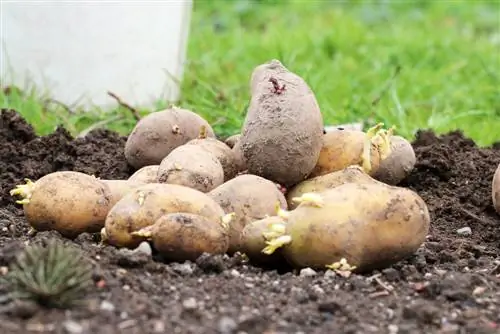
There are various ways to store potatoes for a longer period of time after harvest. But there are a few things to consider.
In the basement
A cellar usually offers ideal conditions for storing vegetables, provided it is frost-proof, cool, dark and dry. Commercially available potato hoards, fruit crates and vegetable boxes can be used for filling. They ensure optimal ventilation of the tubers. Storage on conventional slatted frames is also possible. As an alternative to wooden stairs, you can also use plastic mesh boxes. The bottom and top layer in each container is made up of a layer of newspaper so that the tubers are dry from below and protected from light from above.
If you don't have wooden boxes or mesh boxes available, you can also fill linen or jute bags with the tubers. In these cases, regular inspection for damage or rot is essential. A potato cellar used to be standard in every house, especially in rural regions. Today most cellars are insulated, heated and barely cooler than ten degrees. This means they are no longer suitable for storing vegetables. Then you have to look for alternatives.
Tip:
If you have a sheltered balcony, you can store the potatoes there in mild winter locations. To do this, take a simple fruit box, insulate it as much as possible with straw, into which you then embed the dry tubers and cover them with straw.
Fridge or pantry?
- Refrigerator less suitable for storing potatoes
- It's dark but too cold
- Temperature in the fridge can hardly be regulated
- Inadequate air circulation provided
- Consequences can be mold formation and rot
- Change in the taste and consistency of the tubers possible
- Not ideal, but a little better, unheated pantry or storage room
- Recommended only for smaller supplies
- Be sure to remove purchased potatoes from the packaging before storing them
There is also the option of storage or storage in a special clay pot. It is important to ensure that the clay pot has a lid and is not painted. Of course, you can also use fabric or linen bags or smaller wooden boxes to fill in the pantry. If you decide to use boxes, they must be covered again with a cloth or newspaper after filling to protect the tubers from light.
Tip:
For a small supply, it is usually sufficient to store the tubers in a paper-lined basket or vegetable box in a cool place. Here too, don’t forget the cover for darkening purposes.
In a ground rental
The function of a ground rent is similar to that of a refrigerator. It is a tried and tested method of storing potatoes in a small space. You should make sure that the soil is neither completely dry nor too moist. If the soil is too dry, the tubers will dry out and shrink. To avoid waterlogging, water must be able to drain easily at all times. Consequently, the soil should be permeable. If necessary, the permeability can be improved by adding sand.
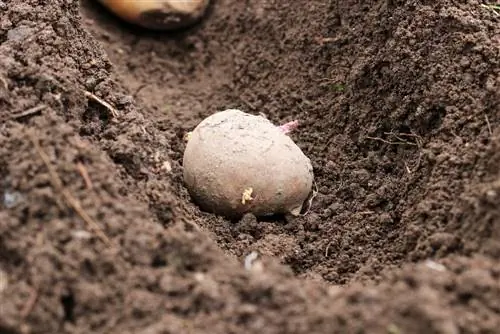
To create a soil rent, choose a partially shaded spot near the house, depending on the groundwater level. Preferably on the north side of a house or another covered spot on the house. This has the advantage that you don't have to travel long distances, especially in winter, and the vegetables also benefit from the heat radiated by the house. The tubers to be stored should be undamaged, dry and free of coarse soil residue.
Create ground rent
- Potatoes cannot tolerate sub-zero temperatures
- Earth rent must above all be low enough
- Size depends on the amount of vegetables to be stored
- Dig a correspondingly large hole for the ground rent
- For storing potatoes at least 60-80 cm deep
- Width of the rental about 150 cm
- Pour a layer of sand about five centimeters high into the pit
- Then line the floor and side walls with close-meshed wire mesh
- For example, with standard mesh or rabbit wire
- Wire mesh should protect against hungry rodents
- Put a thick layer of straw on the wire
- Lay out the tubers next to each other
- Alternate a layer of straw and a layer of potatoes on top of the vegetables
The top layer is straw and then wooden boards or wooden slats. The boards can also be covered with brushwood or dry leaves. On warmer and drier days, it is advisable to briefly open the ground rent for ventilation.
Tip:
Instead of straw you can also use sand or you can use both. The tubers to be stored should under no circumstances be washed before storage, as this would inevitably lead to rot.

